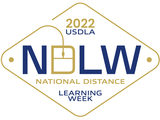Accessibility Essentials: Make Online Courses Accessible
Design Your Course Content for All Learners
UMBC's National Distance Learning Week 2022 Lunchtime Series created space for candid conversations about online learning. The candid conversation on Monday, November 7th focused on course design and Quality Matters.
The Quality Matters Higher Education Rubric (6th edition) is a set of 8 General Standards and 42 Specific Review Standards used to evaluate the design of online and blended courses. QM Standards are research-supported and based on published best practices. The rubric's General Standard 8 focuses on course accessibility and usability, and is designed to assess whether "the course design reflects a commitment to accessibility and usability for all learners."
Creating and adding content to an online course offers students the opportunity to engage with customized course materials, but may not provide equal access if the content is not accessible. The following content creation best practices promote accessibility so that all learners can access course content.
Content Accessibility Best Practices
Media
Add captions to videos.
Visual information that is critical to meaning should include an audio description.
Panopto and VoiceThread offer automated captions. Edit and correct automated captions for accuracy.
Add slide presentations in video lectures to Blackboard for student view.
Provide transcripts for audio files.
Audio files can be uploaded to Panopto for automated captioning.
Images
Provide alternative (Alt) text for all images that are not decorative.
Long descriptions may be appropriate for complex illustrations or graphs.
Add alternative text for images embedded in slide presentations, documents, or individual image files.
When adding an image to Blackboard, use the Alt text field to provide a meaningful description of the image.
Add labels to charts, graphs, and illustrations.
Text
Use text heading levels to format text, instead of editing text size or style.
Use heading levels in order (h1, h2, h3, etc).
Avoid using underlined text unless the text is a hyperlink.
Avoid using text color alone to convey meaning.
Color combinations provide sufficient color contrast.
Links
Hyperlinks in text should describe the link destination.
Use "National Distance Learning Week Lunchtime Series" instead of "click here."
Tables
Create tables with column and/or row headers.
Avoid using tables to format a document. Use text heading styles instead.
Create tables using text. Avoid using tables as embedded images.
What UMBC Resources Support Course Content Accessibility?
Blackboard Ally
Instructors can use Ally to gauge the accessibility of course content.
Receive feedback on the accessibility of course content through an Ally accessibility report.
Improve content accessibility with Ally's step-by-step instructions.
Create alternative formats for course content.
Students and instructors can use Ally to create alternative formats for course materials. This feature allows students to choose the type of file they want that best suits their needs.
SDS Information for Faculty
This SDS faculty resource include
Accessible online/remote teaching resources
UMBC SDS information and tools
Disability Resources for instructors
Quality Matters Impact
As an extension of the award-winningPIVOT program, the Quality Matters Impact program is a new initiative to formally recognize courses that meet Quality Matters standards and demonstrate exemplary online/hybrid course design.
UMBC Instructional Technology
As always, if you have any questions about teaching, learning, and technology at UMBC, please consider the following options:
PIVOT |Academic Continuity |Keep On Teaching |Student Technology Resources
Follow theInstructional Technology &DoIT myUMBC groups
Posted: November 10, 2022, 3:16 PM
